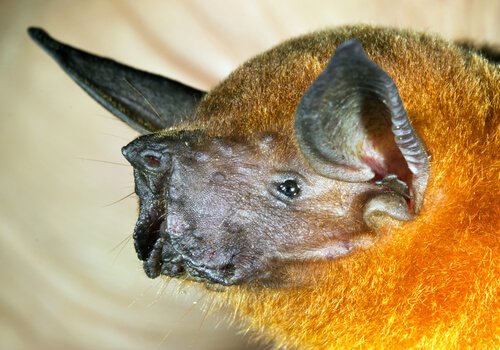Do you know the fisherman bat?
The fisherman bat is one of the smallest species of annealed bats today. His name is a clear reference to the method he uses to catch insects and small fish on the surface of the water. Next, we invite you to know the main characteristics of the bat fisher, its habitat and feeding.
Physical characteristics and taxonomy of the fisherman bat
The fishing bat ( Noctilio leporinus ) is a species of bat or chiroptera belonging to the family Noctilonidae . It is known to be related to the white-bellied bat ( Noctilio albiventris ), also native to the American continent.
Currently, they are known three subspecies of bat fisher:
- Noctilio leporinus leporinus
- Noctilio leporinus mastivus
- Noctilio leporinus rufescens
It is a small and light species, which hardly exceeds 12 or 13 centimeters in length , with a body weight between 40 and 70 grams. On the other hand, his forearm is relatively broad, and can measure up to 88 centimeters long.
The head stands out for the swollen lips, a chin with transverse folds and cheeks that They contain bags to store food. The ears are narrow, pointed and well separated from each other.
The bat's body is perfectly adapted to 'fish' its prey near the surface of the water. Its legs are much longer than most bats, and show amazing strength and flexibility.
The claws of its hind legs, in addition to long and curved, show a remarkable lateral compression. The body of this little fisherman is covered by a short coat, which is orange or reddish in the males, and grayish or brown in the females. The two sexes, male and female, present the belly lighter than the back, while the tail and the membrane of the wings are colored beige. The hairs are slightly more abundant and long on the shoulders and neck . The fisherman bat is a species native to the American continent. Its population extends from Mexico to northern Argentina , including all of Central America and the Antilles. These mammals have preferred to live in humid areas, 
Habitat and feeding of the fisherman bat
It is a carnivorous species that feeds mainly on crustaceans , insects and small fish. Although it may consume invertebrates and some fruits to supplement its nutrition.
The curious fishing 'fishing' technique of the fisher bat
In practice, > The most striking feature of the fisherman bat is its extraordinary 'fishing' technique .Therefore, must wait for fish or other marine animals to make small waves on the surface of the water. When this happens, the fisherman bat knows that it is the exact time for his attack.
When the time comes, is quickly 'launched' in the direction of the prey and uses its long hind legs with powerful claws to catch it. All three known species of bats are anatomically adapted to perform this aquatic capture.
Usually the bat quickly captures its prey and stores it in the pockets of its cheeks. When it reaches a safe place or returns to its' cave ', returns it, completes chewing and swallows it to continue normal digestion.
Initially, researchers have believed that this' fishing' method was only used when there was a shortage of food in the continent . But observing the behavior and nocturnal habits of the fisherman bat, they could identify that it is an extraordinary technique of daily hunting.
Sociability of the fisherman bat
The fisherman bat is usually a sociable species, that lives in small groups that rest in the tall branches of the trees. They are hardly found in caves or holes that we usually associate as bats' shelters.
However, some individuals can maintain solitary habits; During the breeding season, it is easy to see some fisher bat away from the group.


